
Accessibility without harm to parks is goal
From the myriad of colors that shine through when the sun hits the sides of the Grand Canyon to watching Old Faithful erupt at Yellowstone National Park, it truly is a privilege to have accessibility to so many natural and historical sites that are preserved for generations to come.
Can all Americans visit national parks?
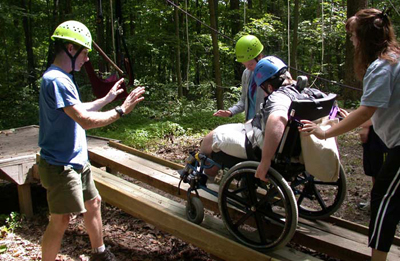 |
Disabled park visitors often find access to be challenging (Photo courtesy of Bradford Woods and the National Center on Accessibility). |
“A trip to Colorado and New Mexico didn’t seem particularly daunting,” wrote New York Times writer Avra Wing. “After all, in the 13 years since I’d lost my right leg, I’d been to, among other places, Israel, China, Hawaii and Italy. Masada; the narrow, muddy streets of Hunan’s cities; the beaches and volcanoes of the Hawaiian Islands; and the endless pedestrian bridges in Venice: none of them offered much in the way of accessibility.”
What is meant by accessibility though? And how far is too far to go to improve a park location for those who are disabled without harming the park’s unique atmosphere and experience?
The questions are not easy to answer.
The approach to answering them that the National Park Service chose to take in its official director’s order #42 was to “develop and coordinate a System-wide, comprehensive approach to achieving the highest level of accessibility that is reasonable, while ensuring consistency with the other legal mandates of conservation and protection of the resources [they] manage.”
“What we try to do is provide access to those with disabilities while still providing the true experience that the park is there for,” said Dave Park, national accessibility coordinator for the NPS.
While keeping a park as natural as possible, NPS must follow other documents’ guidelines in order to satisfy all people universally.
| Wildlife such as this bald eagle is often difficult for disabled visitors to see (Photo courtesy of the National Park Service). | 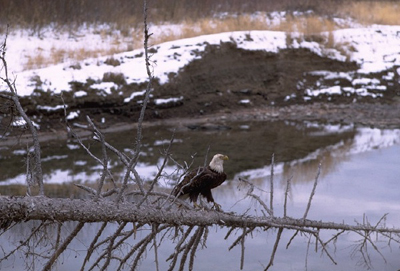 |
In 1973, section 504 of the Rehabilitation Act extended the same protection and rights to people with disabilities as other minority groups.
“Even that statute says that we are not required to do anything toward accessibility if doing so would change the fundamental nature of the environment,” Park stated
The National Park Conservation Association follows the same philosophy.
“We are all for providing access to the disabled as long as it doesn’t harm the park’s natural environment,” said Laura Loomis, senior director of Government Affairs for the NPCA.
According to Loomis, some accessibility adjustments actually turn out better for the environment of the park.
The use of boardwalk-style walkways in certain areas of Glacier National Park and Yellowstone are the examples that Loomis gave.
“At Glacier National Park, the boardwalks are effective because it keeps people from walking on the delicate substrate— soil— and also keeps people on a designated safe path decreasing the chances of wanderers getting lost or even to help prevent slipping and falling on an unmarked ice patch,” said Loomis.
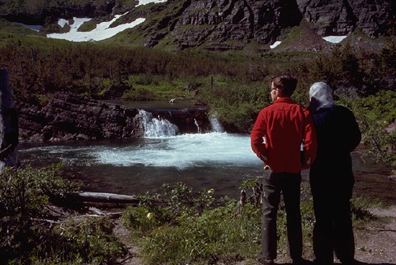 |
Rough terrain makes visiting impossible for some disabled visitors at some locations (Photo courtesy of the National Park Service). |
Yellowstone’s walkway system in certain areas is another great help to the visitor and the environment. Loomis declared that a major problem that was occurring before the walkways was that “visitors would walk in areas where the soil was very delicate near thermal areas and in some cases would actually scald themselves by slipping into small thermal pools.”
Both of these parks have benefited from an accessibility improvement, while at the same time providing easier access for the handicap and disabled.
In addition to the Rehabilitation Act and the NPS’s director’s order mentioned above, the Americans with Disabilities Act has made an official Code of Regulations that national parks and facilities are required to follow. These regulations are explained with detailed definitions and multiple sub-sections so the parks are able to follow the dictated procedures effectively.
For example, an accessible route is defined as “a continuous unobstructed path connecting all accessible elements and spaces of a building or facility.”
From there, the ADA specifies the differences between an accessible route on the interior of a building or in the exterior areas of the facility. An accessible interior route would include wide enough corridors for wheel chair access, level floors, ramps and elevators while an accessible exterior route ranges from parking access aisles, to curb ramps and crosswalks at vehicular pathways.
While all of these regulations are set forth, at this point in time it is impractical to expect for all areas of a national park to be 100 percent accessible to all.
| Grizzly bears search for food at Yellowstone National Park (Photo courtesy of the National Park Service). | 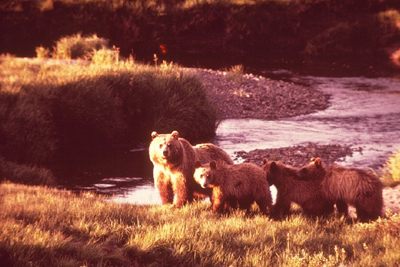 |
“We are never going to be able to make the entire park accessible according to the ADA codes,” said Doug Madsen, Yellowstone National Park’s accessibility coordinator, “but we are constantly trying to make this park universally accessible and allow all people to get some kind of park experience.”
Loomis explained the reasoning for this is because, “The disabled community has not really issued any formal complaints, or pushed for access to all parts of all parks because they recognize the importance to keep these areas in their pristine and natural environments.”
Organizations that promote accessibility improvements for the disabled agree with this viewpoint.
“There has to be a balance,” said the director of the National Center on Accessibility, Gary Robb. “The reason that the parks are there is because of their unique characteristics and too many changes wouldn’t make it fun for anyone including the disabled.”
If both sides agree that accessibility is important as long as it does not overstep its bounds, when have there been instances where a proposal for accessibility improvement was turned down?
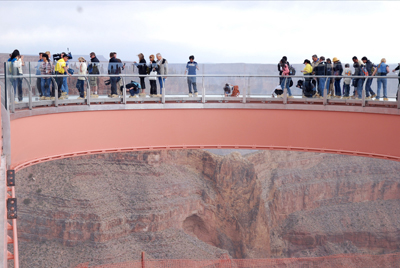 |
The new overlook at Grand Canyon West (Photo courtesy of Grand Canyon Skywalk). |
“One prime example almost happened in Yellowstone in the early 90s,” recalled Loomis.
The former U.S. Senator of Wyoming, Malcolm Wallop, proposed putting a sky lift cable system through Yellowstone’s Lamar Valley, an area famous for its heavy wildlife population including a breeding ground for grizzly bears.
“He got the idea from theme parks and thought it would be a great tourist attraction,” Loomis informed.
The plans were turned down unanimously because it not only would have been an expensive project to build and operate, but it would have totally changed the area’s special natural habitat.
Loomis said that there have been multiple proposals similar to this for Grand Canyon National Park taking people from the base of the canyon to the top without having to make the climb.
“Some things are just unnecessary that harm and take away the challenge and appearance of the Grand Canyon, which is why it is so unique and special,” held Loomis.
One recent change to the Grand Canyon happened at Grand Canyon West, a destination outside of the national park’s boundary and jurisdiction, on private lands owned by the Hualapai Indian Tribe.
The Grand Canyon Skywalk was constructed.
This structure extends 65 feet from the canyon’s edge and hangs 3,800 feet above the canyon floor. The most exclusive aspect of the skywalk is that it has a see-through glass floor where the visitors can actually look to the bottom of the canyon while standing over its edge.
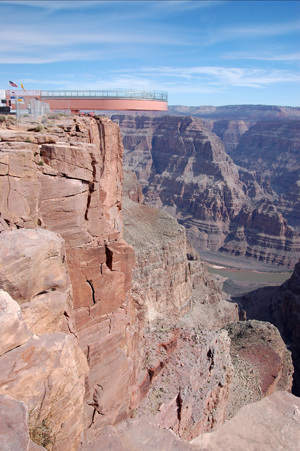 |
The overlook at Grand Canyon West extends well into the canyon for visitors (Photo courtesy of Grand Canyon Skywalk). |
“People can stand on the edge of the Grand Canyon in many locations,” Amanda Hill, publicist for the skywalk, said. “But over the edge is just great! And I personally don’t see it as a desecration to the Grand Canyon. It just offers a chance to experience one of nature’s true wonders in a way that was never offered before.”
Aside from a few controversial additions here and there, generally speaking accessibility improvements are moving in the right direction.
The NPS presents annual awards to parks that make the greatest strides toward universal accessibility called the National Park Accessibility Achievement Awards.
One of the awards is the Director’s Sustained Park Accessibility Achievement Award. This award is given recognizing a park that has made “sustained” efforts to provide and improve equal accessibility for persons with disabilities over a period of at least three years.
The winner in 2006 was the Petroglyph National Monument. Petroglyph has completed 14 different accessibility projects in the past three years as continuous projects, including everything from small scale projects like making every restroom handicap-accessible to construction of smooth, slip-resistant parking spaces, and an accessible path at the Volcanoes Day Use Area, Petroglyph’s main attraction.
Parks like Petroglyph are doing the best that they can to make park visits as enjoyable for all as possible, but funding throughout the system of the 390 units is far below what is needed.
| A geyser errupts at Yellowstone National Park (Photo courtesy of the National Park Service). | 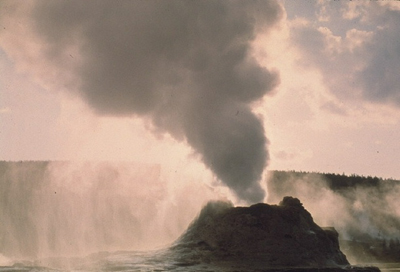 |
“Funding is a major problem with getting improvements done in the national parks,” said NCA’s Gary Robb. “But priorities are another issue where the squeaky wheel gets the oil. Pick up a paper any day and you’ll see back logs of needed park upkeep but a lack of funding and trained personnel make it more difficult.”
What Robb and the NCA are asking is that the government contributes more money to the NPS.
“Funding needs to be made more of a priority, because if it is not a priority, then it won’t get done,” he stated.

Comments are Closed